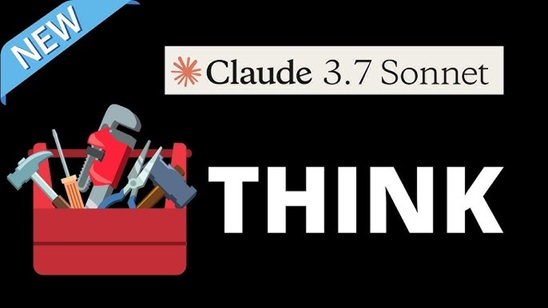
Introduction
This analysis explores Anthropic’s recently introduced “THINK” tool for Claude 3.7 Sonnet. While its name suggests a simple scratchpad, it is actually a sophisticated system that represents a major advance in how AI models handle complex tasks requiring structured reasoning and policy compliance. This discussion examines the tool’s integration with broader AI reasoning capabilities and test-time compute scaling.
About Claude 3.7 Sonnet’s “THINK” Tool
What is the THINK Tool?
The THINK tool is a specialized feature introduced for Claude 3.7 Sonnet that creates a dedicated space for structured thinking during complex problem-solving tasks. Unlike a simple scratchpad, it’s designed to improve Claude’s performance with complex reasoning, tool use, and policy adherence.
How it Works
The THINK tool functions as:
- A dedicated memory space where Claude can pause and reflect
- A structured environment where Claude can process information from previous tool calls
- A framework for verifying that actions comply with policies and guidelines
- A mechanism for tracking complex multi-step reasoning
The tool uses a standard JSON specification format with a simple structure:
- Name: “think”
- Description: Used for complex reasoning without changing databases or obtaining new information
- Input schema: An object with a “thought” property containing a string
When to Use the THINK Tool
The THINK tool is particularly effective in scenarios where Claude needs to:
- Process outputs from multiple previous tool calls before taking action
- Follow detailed guidelines and verify compliance with specific policies
- Execute sequential actions where each step builds on previous steps
- Manage complex reasoning that requires maintaining and reviewing information
The Power of Pairing with Optimized Prompts
What makes the THINK tool truly powerful is when it’s combined with optimized prompts. These prompts provide:
- Templates for policy verification
- Structured steps for gathering and validating information
- Guidelines for planning and executing actions
- Frameworks for rule compliance verification
In benchmark tests, the combination of the THINK tool with optimized prompts significantly improved Claude 3.7 Sonnet’s performance on complex tasks by over 50%, particularly in domains requiring strict policy adherence like flight booking systems.
Real-World Applications
The THINK tool is especially useful for:
- Customer service scenarios requiring adherence to company policies
- Multi-step workflows like booking, reservations, or financial transactions
- Complex decision-making processes with rule-based constraints
- Situations where interaction with multiple databases or tools is needed
Limitations and Considerations
The THINK tool represents an approach that uses external reasoning structures rather than relying solely on the model’s inherent capabilities. This suggests that:
- Claude may benefit from these external structures for complex reasoning tasks
- The significant performance improvement with the tool indicates areas for potential model enhancement
- Future developments might integrate these structured reasoning approaches more natively into the model
Video about Sonnet 3.7 “THINK” Tool:
Summary for the video about:
Understanding the THINK Tool’s Position in AI Architecture
The video begins by contextualizing the THINK tool within the broader AI development landscape. The presenter clarifies that while it might sound similar to Anthropic’s previously announced “extended thinking” capability, it’s actually a distinct feature that operates within the test-time compute scaling regime. The THINK tool creates a dedicated space for structured thinking, significantly improving Claude’s performance in complex problem-solving scenarios, particularly for agentic tool use.
The 𝜏-Bench Research Connection
The THINK tool is as research from Sierra Research’s 𝜏-Bench (Tool Benchmark for agent-user-tool interaction) published in June 2024. This research identified three main reasons why function-calling agents often fail:
- Complex reasoning over structured data – agents often provide incorrect arguments or omit necessary details
- Policy adherence failures – agents frequently make incorrect decisions by not following provided rules
- Handling compound requests – agents sometimes only partially complete multi-step tasks
The Real Power: THINK Tool + Prompt Optimization
The most significant insight from the video is that the THINK tool alone provides minimal performance improvements. However, when paired with an optimized prompt that provides a structured template for reasoning, the performance improvement jumps dramatically (by over 50% according to the presenter). The optimized prompt essentially provides:
- A template for policy verification
- Structured steps for information collection
- Guidelines for action planning and execution
- A framework for rule compliance checking
Use Cases for the THINK Tool
This article outlines several scenarios where the THINK tool is particularly effective:
- When Claude needs to carefully process outputs from previous tool calls
- In policy-heavy environments requiring guideline adherence
- When actions build sequentially upon previous steps
- For complex reasoning chains that require tracking multiple variables
Conclusion and Key Takeaways
The THINK tool marks an important step forward in improving AI systems’ ability to handle complex, policy-driven tasks with multiple steps and dependencies, making Claude 3.7 Sonnet more effective at tasks requiring careful deliberation and rule following.
This article concludes with several important insights:
- The THINK tool is not merely a scratchpad but a structured reasoning framework that significantly improves Claude 3.7 Sonnet’s performance when paired with optimized prompts
- The tool represents an approach to rule-following that uses external tools rather than inherent capabilities
- The significant performance improvement raises questions about Claude’s inherent self-reflection and validation capabilities
- The implementation parallels in-context learning (ICL) approaches from earlier AI developments


